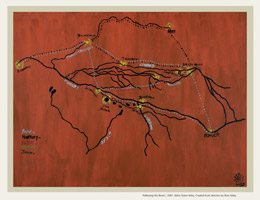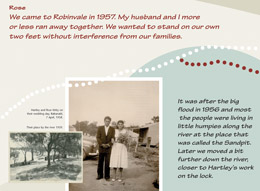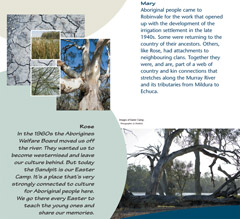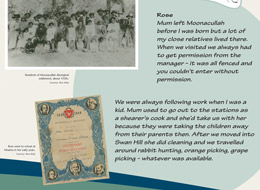| Robinvale perspectives |
Rose Kirby: An Indigenous perspective
![]()
Following the rivers
Rose has a strong sense of the connection between the neighbouring tribes and clans whose traditional country is around the Murray, Edward and Murrumbidgee rivers in what is now south western New South Wales and north western Victoria. ‘Following the rivers’ was the way she saw their traditional seasonal migrations as well as the way they moved in response to white settlement.
 Rose and Karen Kirby at National Museum of Australia. Photograph: Lannon Harley, 2007. Courtesy National Museum of Australia. |
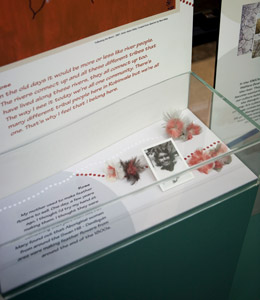
|
|
| View of Rose’s story on display
at Robinvale. Photograph: Jo Sheldrick, 2007. |
Mapping the personal, the local and historical
For the exhibition, Rose worked with her daughter, Karen, to create a map showing the movements of earlier generations of her family along the rivers. It includes her own tracks and those of her husband, as well as their journey to Robinvale.
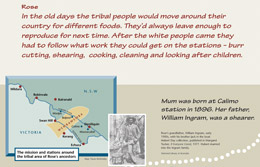 |
||
| Following the Rivers, Karen and Rose Kirby, 2007. | Detail from Rose Kirby, panel one, Migration Memories: Robinvale. Design: Paula McKindlay. |
The exhibition also used a map of the Aboriginal mission settlements and pastoral stations to show the context in which Rose’s forebears were moving around their traditional country for shelter and work after colonial settlement.
The local
| Detail from Rose Kirby, panel three, Migration Memories: Robinvale. Design: Paula McKindlay. |
From the early to mid twentieth century, Aboriginal people in the Robinvale region were virtually invisible. They started arriving in the town in significant numbers when work became available as a result of the establishment of irrigation blocks. Some were returning to the country of their ancestors. Others, like Rose, had attachments to neighbouring tribal groups.
| Detail from Rose Kirby, panel three, Migration Memories: Robinvale. Design: Paula McKindlay. |
The Aboriginal people who came for work at this time were seeking an independent living and an alternative to work on pastoral stations and life on the old mission settlements – many of which were being disbanded. But the Aborigines Welfare Board established a new settlement in Robinvale and forced people to live there. It was not until the 1970s that Aboriginal people were able to move into town. In later years they have also reclaimed the special land they first camped on.
The personal in historical context
Rose spent her early life with her mother, older sisters and other relatives who had strong ties to Moonacullah mission on the Edward River near Deniliquin. Her childhood memories provide a glimpse of life for Aboriginal people in the 1930s and '40s.
| Detail from Rose Kirby, panel one, Migration Memories: Robinvale. Design: Paula McKindlay. |
Looking back on the project
Rose
I was thinking, ‘oh, have I got the courage to stand up there and to tell ’em all this?’ It’s different talking to you about it, but how am I going to go when it’s up there?.. [But] it was fantastic… just to have everyone else come up and say, ‘oh we didn’t know this!’… and you know it was fantastic like with Kay Grose when she said she found some of the answers in my story to match hers.
 |
| Rose Kirby at Easter Camp. Photograph: Jo Sheldrick, 2007. |
Mary
Rose and I had both hoped that a Latji Latji elder or descendant might be interested in participating in the project, but in the end it seemed that Rose herself was in the best position to take the plunge. It was a rewarding process for me as well as for her. I particularly enjoyed seeing the wider community response to her feather flowers and her growing confidence in reviving the art that her mother and other Aboriginal women had developed on the basis of old knowledge, to help them earn a living.

